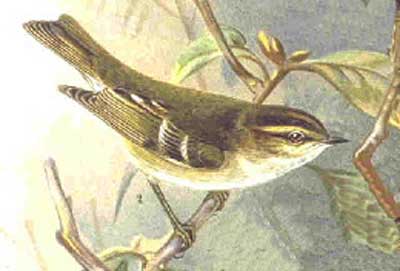Phylloscopus inornatus (*) Cladus: Eukaryota Name Phylloscopus inornatus (Blyth, 1842) Vernacular names
The Journal of the Asiatic Society of Bengal 11 p.191 ----- he Yellow-browed Warbler or Inornate Warbler (Phylloscopus inornatus) is a leaf warbler (family Phylloscopidae) which breeds in temperate Asia. This warbler is strongly migratory and winters in tropical Southeast Asia. Like most similar birds, it was formerly included in the "Old World warbler" assemblage. It was formerly considered to comprise of three subspecies, but humei and mandellii are now split as a separate species (Hume's Leaf Warbler), leaving P. inornatus monotypic. The two sister species differ slightly but consistently in morphology, bioacoustics, and molecular characters.[1] This is one of the smallest "Old World warblers", 9.5-10 cm long: Like most other leaf warblers, it has greenish upperparts and off-white underparts. However, its prominent double wing bars – one long and one short –, lighter stripe on the blackish crown, yellow-margined tertial remiges and long supercilia are quite distinctive. Its song is weak and high pitched; the call is faintly disyllabic. The only real possibility of confusion is with the similar-looking Hume's Leaf Warbler (P. humei), which in the limited area of overlap has duller colours, a faint second wing bar and dark legs and lower mandible. Their vocalizations are clearly distinct. Ecology and evolution This is an abundant bird of lowland and montane woodlands; particularly in winter quarters it may also be found in agricultural areas. Its breeding range extends from the Urals eastwards to China, well north of the Himalayas and its associated mountain ranges. Its winter habitat is lowland broadleaf forest, and in winter quarters it rarely seen north of eastern India and hardly ever at altitudes over 1,000 m ASL [2] . This tiny warbler is prone to vagrancy as far as western Europe in late September and October, despite a 3,000 km distance from its breeding grounds. For example, this species occurs in late autumn in Great Britain regularly enough that it is not classified as rare there. This bird is not shy, but its arboreal life style makes it difficult to observe. It is constantly in motion. Like most "Old World warblers", this small passerine is insectivorous. The nest is built in a tree. A common species in most of its wide range, the Yellow-browed Warbler is not considered threatened by the IUCN.[3] The Western Hume's Leaf Warbler's range overlaps with that of the Yellow-browed Warbler in the western Sayan Mountains, but the species apparently do not hybridize. Their lineages diverged roughly 2.5 million years ago.[4] Footnotes 1. ^ Alström & Olsson (1988), Shirihai & Madge (1993), Irwin et al. (2001), Sangster et al. (2002)
* Alström, Per & Olsson, U. (1988): Taxonomy of Yellow-browed Warblers. Brit. Birds 81: 656–657. Source: Wikispecies, Wikipedia: All text is available under the terms of the GNU Free Documentation License |
|

